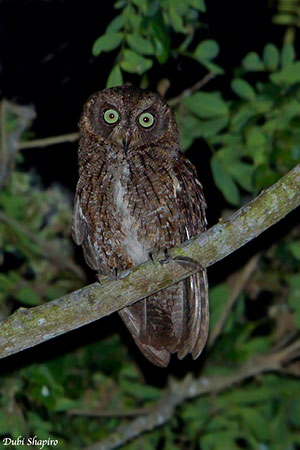
RANGE:
The Mayotte Scops-Owl is endemic to Mayotte Island in the Comoros Archipelago.
HABITAT:
The Mayotte Scops-Owl frequents evergreen forest and can be seen in degraded wet forest. Its habitat includes a variety of woodlands with large trees, exotic forest and areas with trees near coastal human settlements.
CALLS AND SONGS: SOUNDS BY XENO-CANTO
The Mayotte Scops-Owl gives hollow “woohp-woohp” at long intervals, slightly different from that of the Rainforest Scops-Owl, with slower and deeper notes. The sound is clear, without any purring.
BEHAVIOUR IN THE WILD:
The Mayotte Scops-Owl feeds mainly on various insect species including hemipterans, cicadas, beetles and mantises (from stomach contents of several owls). Small vertebrates such as mice, geckos and frogs are probably part of the diet too.
Like most Strigidae, it has nocturnal habits and hunts in the darkness both on trees and on the ground.
The breeding behaviour is very poorly known. The members of genus Otus are usually monogamous with strong pair-bonds.
The Mayotte Scops-Owl is apparently resident.
The flight is silent and the bird only performs short flights.
REPRODUCTION OF THIS SPECIES:
This behaviour is almost unknown.
The Mayotte Scops-Owl probably nests in natural cavities such as tree holes.
The female lays white eggs and incubates usually alone while the male feeds her during this period.
The breeding season is closely related to food availability.
PROTECTION / THREATS / STATUS:
The Mayotte Scops-Owl is considered as locally common, but as a species living on a small island, it may be vulnerable to habitat destruction, and especially forest destruction. The introduced Common Myna may involve competition for nesting sites.
The population size is unknown, but it is suspected to be stable, and the species is not globally threatened.
The Mayotte Scops-Owl is currently evaluated as Least Concern.
Fr: Petit-duc de Mayotte
Ang: Mayotte Scops-Owl
All: Mayotte-Zwergohreule
Esp: Autillo de la Mayotte
Ita: Assiolo di Mayotte
Nd: Mayottedwergooruil
Sd: mayottedvärguv
Photographer:
Dubi Shapiro
Dubi Shapiro Photo Galleries & Dubi Shapiro's Pictures on IBC
Text by Nicole Bouglouan
Sources:
HANDBOOK OF THE BIRDS OF THE WORLD Vol 5 by Josep del Hoyo-Andrew Elliott-Jordi Sargatal - Lynx Edicions - ISBN: 8487334253
OWLS OF THE WORLD – By Claus König, Friedhelm Weick and Jan-Hendrik Becking - IBSN 978-0-7136-6548-2
Owls of the World - A Photographic Guide: Second Edition De Heimo Mikkola – Editeur: Bloomsbury Publishing, 2017 – ISBN: 1472945611, 9781472945617 – 536 pages
Birds New to Science: Fifty Years of Avian Discoveries De David Brewer – Editeur: Bloomsbury Publishing, 2018 – ISBN: 1472906292, 9781472906298 – 416 pages
Wikipedia, the free encyclopaedia
Mayotte Scops-Owl
Otus mayottensis
Strigiformes Order – Strigidae Family
INTRODUCTION:
The Mayotte Scops-Owl was considered a subspecies of the Rainforest Scops-Owl (Otus rutilus) until recently, but it is now treated as a full species. It differs from the Rainforest Scops-Owl by the song, the larger size and some details in plumage colour and pattern.
This species is endemic to Mayotte Island in the Comoros Archipelago. It frequents evergreen forest and a variety of woodlands with large trees. It feeds primarily on various insects species. Its breeding behaviour is very poorly known.
The Mayotte Scops-Owl is described as locally common and the population seems to be stable.
DESCRIPTION OF THE BIRD:
Biometrics:
Length: 24 cm
Weight: 120 g
The Mayotte Scops-Owl has greyish-brown plumage on the upperparts, with dark vermiculations and streaks. There is a nuchal collar with pale and dark spots. The scapulars show a weak, white stripe. On the upperwing, the flight-feathers are dark greyish-brown with paler barring.
On the underparts, the throat is white with conspicuous dark streaks and bars. Rest of underparts is brownish with dark streaks and vermiculations. Belly and undertail are weakly spotted whitish.
On the head, the short ear-tufts are mottled pale and dark greyish-brown. The facial disk is dark greyish-brown but the dark rim is indistinct.
The bill is greenish-yellow with dark tip. The eyes are yellow. On the legs, the tarsi are feathered to the base of the bare greyish-brown toes. The claws are blackish.
There is a rufous morph with dark tawny-brown upperparts and entirely paler rufous-brown underparts. The plumage pattern is similar. This morph is much rarer than the previous.
Male and female are similar, but the female has slightly longer wings.
The juvenile resembles adult, but rectrices and tertials show more conspicuous bars.
